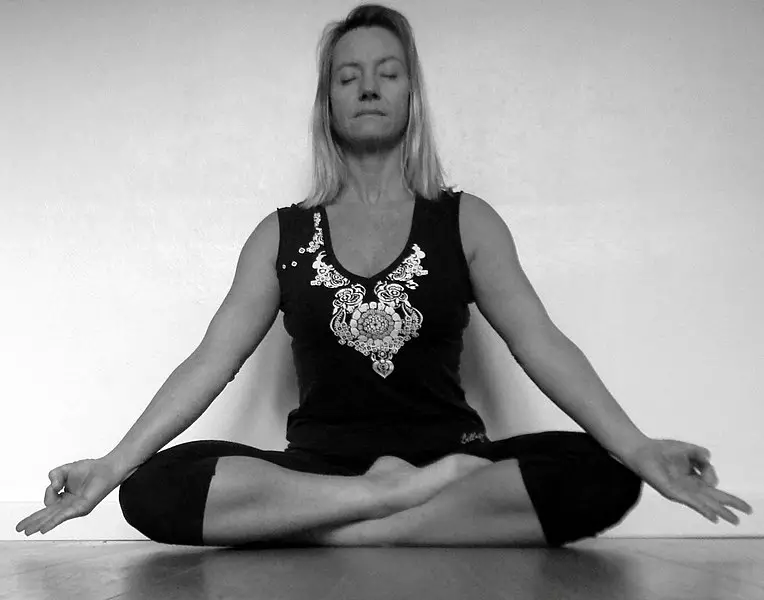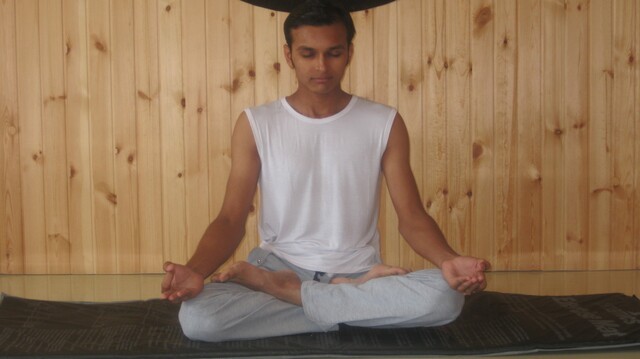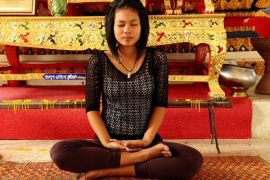Breathing Exercises Full Yoga Breathing (PRANAYAMA)
Full yoga breathing means that the lung capacity is fully utilized. The lungs are then maximally ventilated. This not only benefits health. Deep yoga breathing is also the basis of pranayama.
This aspect of the aforementioned hatha yoga discipline aims at full breath control, including through the use of breathing techniques. Proper breathing takes a central place in daily life because prana or life energy is absorbed with the breath.
The yogi tries to control this cosmic energy with all kinds of exercises, for example, by alternately breathing through one nostril and holding the breath (kumbhaka) with full and empty lungs. Full yoga breathing, or deep breathing, precedes these pranic exercises that are an integral part of hatha yoga.
Prana, pranayama, and breathing exercises
In hatha yoga, the breath is considered the link between body and mind, and in a broader sense, the connection between the conscious and subconscious. Pranayama strives for the control of prana, or the life energy that manifests itself in physiological terms in vitality, because of the body processes in general, such as the gas exchange in both the lungs (vesicles) and the body cells, and the cooperation between the cells. System organs (heart, lungs, brain, etc.) went better.
Breathing techniques
Everyone knows that there is a close link between breathing and moods. Those who are nervous and excited, breathe differently than those who quietly watch a relaxing TV program on the couch. The reverse is also true.
With the right breathing, one can, so to speak, ‘anticipate’ certain negative moods and states of mind. Whoever wants to do the Indian yogic breathing techniques (pranayama), in addition to the yoga postures (asana), must first gain insight into normal breathing and improve it in daily life.

Siddhasana with jnana mudra / Source: Jemasty, Wikimedia Commons ( CC BY-SA-3.0 )
Ventilation spaces of the lungs
To understand the physiology of full yoga breathing , it is important to know something about the ventilating spaces in the lungs . With normal (read: superficial) breathing, between 300 and 500 ml of air is inhaled and exhaled. This is called the breath volume (AV). The minute volume (AMV) is the amount of air that is ventilated per minute.
The inspiratory (IRV) and expiratory reserve volume (ERV) is addressed as soon as you breathe in and out deeper, which is the case with full yoga breathing and what is called the vital capacity, or the ‘normal’ breathing volume and the IRV and ERV together. This means the entire lung capacity not yet used. After all, the lungs also have an inspiratory and expiratory residual space that is never addressed. Even with forced inhalation and exhalation, one cannot ‘get there’.
Belly, diaphragm and chest breathing
With shallow, shallow breathing, which does not make full use of lung capacity, the body cells receive less oxygen than is usually necessary, and the lungs cannot optimally release the carbon dioxide into the air. The kidneys, the liver, and the intestines will also function less efficiently, and the heart will have to endure more to manage the physiological processes in spite of everything.
Complete breathing
Full or complete yoga breathing is, in addition to the health aspects, also essential because all of the following pranayama exercises are based on this breathing type. There are three aspects to full yoga breathing:
- Abdominal breathing (deep breathing)
- Diaphragm breathing (flank breathing)
- Breast breathing (high breathing)
The full yoga breathing the basis of pranayama (breathing exercises)
All pranayama exercises are based on full yoga breathing. Both abdominal, diaphragm, and chest breathing should be dealt with during each inhalation and exhalation. First, the belly expands (breathing the stomach), then the flanks (diaphragm breathing), and then the chest. The breath takes place in reverse order. Practice this breathing technique in daily life, at home, and work. Ultimately you will breathe intuitively in this way. It forms the best basis for all pranayama techniques that you want to dedicate yourself to in the future.

Padmasana (lotus position) / Source: Drchirag , Wikimedia Commons ( CC BY-SA-3.0 )
Technic
You must adopt a comfortable position, lying or sitting in a chair, in a cross-legged position, or ideally in padmasana (lotus position) or siddhasana (completed position). In the latter meditation positions, you force the back and pelvis to the ideal position for pranayama exercises. During this breathing technique, Jalandhar bandha is only important if you also hold your breath ( kumbhaka ).
Press the chin into the upper cavity of the sternum ( sternum ). Place your hands on your knees or place them in jnana mudra.
- Breathe slowly and evenly through the nose (think of jalandhara bandha ). The inhalation is called puraka . You press the diaphragm downwards, after which the abdomen expands, and the lower lung spaces automatically fill with air, simply because they get the space for it (abdominal breathing).
- A wave movement now arises, causing the flanks to expand (diaphragm breathing), followed by the chest.
- Ultimately, the lung tops also fill with air if you ‘create space for it with your shoulders.’
- Hold the breath for a few seconds. This is called antara kumbhaka .
- Exhale slowly and evenly ( recaka ), withdrawing the abdomen and lifting the diaphragm. The ribs and shoulders fall naturally.
- Hold your breath with empty lungs ( bahya kumbhaka ).
- Practice full yoga breathing for about five minutes. Important is the slow, smooth, and even inflow and outflow of air. Visualize that you create space for this surging wave movement in the chest and abdomen. In short, allow breathing to happen naturally and do not force anything.
Health effects of full (deep) yoga breathing
What matters is that you learn to use (almost) the entire lung content in daily life as a preparation for the pranaya techniques. So you can also do the full yoga breathing on foot, or in the office behind the computer. In addition to the pranic aspects that are important in yoga practice, deep, regular, and even breathing has many health benefits. A small selection:
- Extra intake of oxygen through the lungs in the blood. Cellular metabolism (incineration) thus runs better.
- Thanks to the deep respiration, the carbon dioxide is released to the air more effectively and ultimately optimally through the lungs.
- The lungs are better ventilated. This benefits the elasticity of the lung tissue. ‘Spoiled’ air is always removed adequately.
- A favorable course of gas exchange thanks to a larger lung area.
- Proper breathing ensures a better physiological condition …
- and guarantees a calm and calm mind in all circumstances because the nervous system comes to rest.
- More vitality in daily life.
- Thanks to the abdominal breathing part of the yoga breathing, the abdominal organs are massaged. This is good for, among other things, liver and kidney function, digestion, and bowel movements.
- The physical endurance increases; people are less likely to get out of breath.

